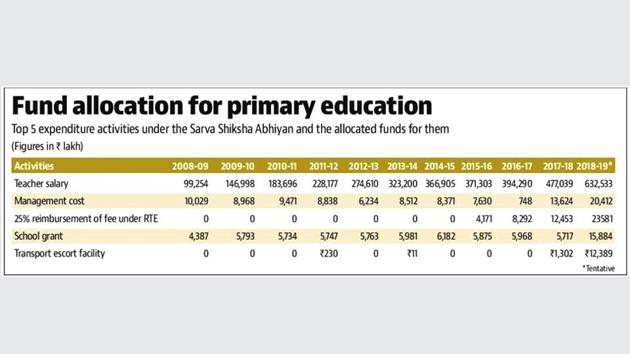Four-fold rise in education funds in 10 years, but students’ learning levels down
Under the Sarva Shiksha Abhiyan, expenditure on primary education in Rajasthan increased by 4.58 times between 2008 and 2018, which was revealed by the state government in reply to a question raised in the assembly recently.
Despite more than fourfold increase in the expenditure on primary education in Rajasthan over past 10 years, the Annual Status of Education Report (ASER) shows that learning levels of the students have gone down in the state.

ASER is an annual survey that aims to provide reliable estimates of children’s enrolment and basic learning levels in India.
Under the Sarva Shiksha Abhiyan, expenditure on primary education in Rajasthan increased by 4.58 times between 2008 and 2018, which was revealed by the state government in reply to a question raised in the assembly recently. Under the Sarva Shiksha Abhiyan, the government spent ₹16,293.73 million on primary education in Rajasthan in 2008-2009, which went up to ₹74,728.19 million in 2018-2019. The increase in the expenditure over 10 years amounts to 358.63%.
However, when the ASER for 2008 and 2018 is compared, it shows that the learning levels of primary school students have deteriorated.
According to the ASER 2008, the percentage of Class 1 students who were unable to read was 50%. However, ASER 2018 says there were 63.8% Class 1 students who were unable to read.
Similarly, the percentage of Class 3 students who were unable to read in 2008 was 3%, while in 2018 the percentage of such students was 14.1%.
The percentage of Class 3 students who could read words in 2008 was 28.5%, which decreased to 18.3% in 2018.
A sharp contradiction in the investment and learning level of the students was witnessed in 2010-2011. A major increase of 33% in the expenditure under the Sarva Shiksha Abhiyan was witnessed in 2010-2011 in comparison to 2009-2010.
As per the ASER 2010, the percentage of Class 4 students who could read nothing was 2.6%, which increased to 4% in 2018. Similarly, the percentage of Class 5 students who could perform subtraction was 35% 2010-2011, which decreased to 23.45 in 2018. In subsequent years also, the expenditure on primary school education increased but learning levels of the students continued to go down further (see graphic).
Commenting on the issue, educationist KB Kothari said that most parts of the increased funds are spent on teachers’ salary when the funds should be spent on foundational learning.
“Over 70-80% the government expenditure goes on teachers’ salary. The availability of fund for improving the quality of learning has a very limited portion of budget allocation. And when the quality of learning has such a low level of financial allocation, the differences in quality of learning is not taken as a very distinct area of improvement,” he said.
“Unless the accountability of learning outcome is not assigned to teachers, the increase in expenditure on teachers’ salary is not sufficient to improve learning outcomes. Money has to be really allocated for foundation learning, of which language and arithmetic forms a major part. Also, the money should be spent on remedial learning which should be for the students who fail to perform well in foundational learning,” he added.












